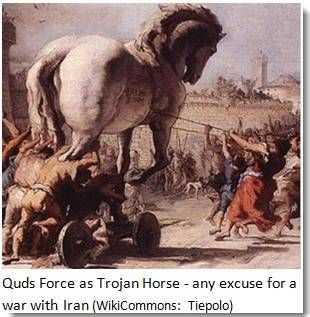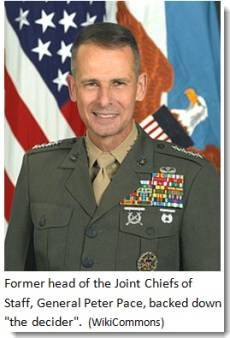(Washington, DC) A faction of the Iranian Revolutionary Guard called the Quds Force (QF) is center stage in the War on Terror for the second time in five years. In 2007, President George W. Bush hauled out the group of middle and upper level Iranian government officials as a rationale for military action against Iran. The decisive shutdown of the Bush effort marks a critical turning point in recent history and will be discussed later in the article.
QF II began last Tuesday when FBI Director Robert Mueller and Attorney General Eric Holder unified the terror storyline between the rabid neoconservatives of the Bush era and the low key loyalists to the national security state in the Obama administration.
Holder and Mueller accused, "elements of the Iranian government of plotting to assassinate the Saudi ambassador to Washington," the Washington Post reported on Tuesday. In essence, this military faction allegedly hired an outsider to murder the Saudi ambassador to the United States. With the full knowledge of the Iranian government, the outsider tried to hire a Mexican drug lord for the high level hit. Attorney General Holder announced that the United States is "holding the Iranian government accountable." Holder went on to state the official position of the government, namely that the Iranian government entity behind the plot was the Quds Force.
The current version of Quds Force-as-archvillain was met with challenges from the start. Early on in the Post article, an unnamed White House official offered this qualifier: "There's a question of how high up did it go." That makes sense. The QF is not the entire Iranian government. The anonymous spokesman said that the Iranian government has a "responsibility to explain that."
The broader reaction has been more direct. The Christian Science Monitor ran three articles questioning the link between QF and the alleged plot to kill the Saudi Arabian Ambassador, Adel A. Al-Jubeir. Commenting on the hearing for accused plotter, Manssor Arbab Arbabsiar, the Monitor's Scott Peterson reported widespread skepticism, "Why the plot doesn't add up?" He quoted a Rand Corporation researcher who noted that the case doesn't fit Iran's normal mode of operation. Peterson went on to report that when Iran's government murders individuals overseas, they do it with trusted insiders to kill, not rookies who contract with drug dealers. The second Christian Science Monitor story was a report by Roy Gutman of McClatchy News noting the refusal of Saudi Arabia's government to implicate Iran in the plot.
CNN carried the outline of the charges but hedged by quoting former CIA agent Robert Baer and former National Security Council mainstay Gary Sick, both of whom voiced serious doubts.
The most comprehensive critiques of the allegations by Holder and Mueller came from Glenn Greenwald and Cenk Uygur. On the Young Turks, Uygur openly mocked the claimed plot. Glenn Grunwald delivered a scathing critique of the facts, logic, and motivation of the alleged plot.
When President Bush held the Quds Force responsible for killing U.S. soldiers in 2007, the stakes were higher since the charge was close to, if not an actual act of war. The response at that time was forceful but not well covered in the news, even though it came from the Chairman of the Joint Chiefs of Staff, General Peter Pace, and longtime foreign policy actor and scholar, Zbigniew Brzezinski.
Quds Force I, February 2007 - Revving Up to Go After Iran
This is the second time that the Quds Force has been accused of attacking the United States. In 2007, when President George W. Bush was making his case for going after Iran, he and the neoconservatives claimed that the group provided weapons to Iraqis who, in turn, were using those weapons to kill U.S. soldiers. The following sequence of events demonstrates how elements of the power structure at the time undercut Bush.
February 9, 2007:
Seville, Spain. Gates surfaces the Iranian connection to Iraqi weapons
with tentative statement: "'I think there's some serial numbers, there
may be some markings on some of the projectile fragments that we found'
that point to Iran, he said.' (Washington Post)
February 11: "Senior military officials" in Baghdad give an anonymous press briefing with evidence of Iranian weapons used to kill U.S. soldiers in Iraq. The Quds Force is named as the supplier. (Washington Post)
February 12: Canberra, Australia. Chairman of the Joint Chiefs of Staff, General Peter Pace, denies that there is a demonstrated link between weapons found in Iraq and the Iranian government. "We know that the explosively formed projectiles are manufactured in Iran. What I would not say is that the Iranian government, per se [specifically], knows about this." (Voice of America)
February 13: Jakarta, Indonesia. General Pace reiterates that the military briefers, under his command, are over reaching: "That does not translate that the Iranian government per se, for sure, is directly involved in doing this." (Like the skeptical anonymous Obama White House source on QFII, Pace said Iran had to explain how its weapons got to Iraq.) (Associated Press)
February 14: Washington, DC. President Bush claims that Iranian weapons found in Iraq are from the QF and, as such, from the Iranian government. "What we do know is that the Quds force was instrumental in providing these deadly IEDs to networks inside of Iraq. We know that. And we also know that the Quds Force is a part of the Iranian government. That's a known." (CNN)
February 14: Honolulu, Hawaii. General Pace states for a third time that there is no proven link between the weapons found in Iraq and the Iranian government. He repeats the statement quoted above from February 13, exactly. (Voice of America)
(Note: You can view every article as one long page if you sign up as an Advocate Member, or higher).






